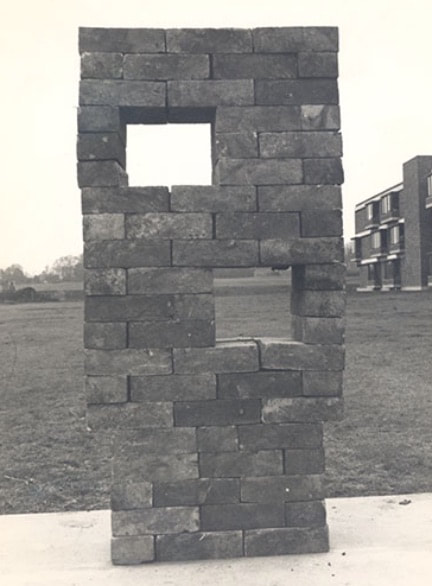An Art Lover's Guide to Cambridge - Dame Barbara Hepworth, Four-Square (Walk Through), 19665/8/2020 As we prepare to celebrate the 75th anniversary of VE Day, it seems appropriate to look at an iconic sculpture at Churchill College. Barbara Hepworth’s Four-Square (Walk Through) dominates the landscape beyond the college’s main concourse and is a focus for the college community, as well as a number of student pranks! Churchill College on Madingley Road was founded in 1960 as a memorial to Britain’s great wartime leader, in part inspired by a post war visit that Sir Winston Churchill made to the Massachusetts Institute of Technology in 1949. Churchill’s vision was for a similar institute in Britain, dedicated primarily to science and technology. In a speech made on the site of the new college ten years later, he reflected on Britain’s global position: “Since we have neither the massive population, nor the raw materials, nor yet adequate agricultural land to enable us to make our way in the world with ease, we must depend for survival on our brains”. (1) The modern, Brutalist design of the new college was complemented then, as it is now, by contemporary sculpture. Barbara Hepworth, Britain’s leading sculptor and a friend of a college fellow, agreed to lend her work Squares with two circles, 1963. When it was subsequently sold to a private collector and removed, the students created their own 'Hepworth' on the plinth of the missing sculpture. The ongoing building work meant that there were plenty of bricks around - see below. The story goes that Hepworth was delighted with the students' tribute and promptly offered to provide the college with another sculpture: "I have just had cast a new work which I feel would be even better for your wonderful site. You can walk through it. It has no front and no back! Walking through is lovely as one can lean out through the lower circles & survey the landscape, or look up to the high circles & see the clouds, the sun, moon & stars.” (2) Four-Square (Walk Through) is one of Hepworth’s most monumental sculptures standing over 4 metres tall. Before she started working in bronze in the 1950s, the scale of her work had been limited by the physicality of carving in stone or wood. Bronze allowed her to create large scale works which coincided with prestigious international commissions and increased demand for public art. In Four-Square (Walk Through), she invites us to question how and what we see - "You can't look at sculpture if you don't move, experience it from all vantage-points, see how the light enters it and changes the emphasis" (3). Are the squares really square? Where do the circular voids lead the eye? How do these shapes speak to the architectural forms around them? By engaging and interacting with this huge sculpture, walking around it and through it, we are encouraged to see the world in different ways, to explore different viewpoints and to reflect on different perspectives. It is a lesson in looking and thinking as relevant today as in the 1960s. Above: Four-Square (Walk Through), Dame Barbara Hepworth (1903-1975), bronze (2/3), 429 x 199 x 229cm, Churchill College, Cambridge below: the undergraduates' tribute to Barbara Hepworth's original work, 1967 and sketch enclosed in BH letter to Kenneth McQuillen. Notes (1) Sir Winston Churchill speech, 1959 Churchill College archive CHUR5/62D/571 (2) Letter from Dame Barbara Hepworth to Dr Kenneth McQuillen, 8th October 1967. College archives, CCPP 1/10/5. (3) Barbara Hepworth quoted by Edwin Mullins, 'Scale and Monumentality: Notes and Conversations on the Recent Work of Barbara Hepworth', Sculpture International, no.4, 1967
0 Comments
Leave a Reply. |
AuthorAll posts written and researched by Sarah Burles, founder of Cambridge Art Tours. The 'Art Lover's Guide to Cambridge' was sent out weekly during the first Covid 19 lockdown while Cambridge museums, libraries and colleges were closed. Archives
December 2020
Categories |



 RSS Feed
RSS Feed